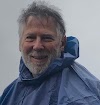Update: I just heard from team leader Daniel Falush that there is a YouTube version of the slideshow tracing humanity's journey, complete with music!
Tracing Humanity's Path
By Michael Balter
ScienceNOW Daily News
23 May 2008
Archaeologists and anthropologists worldwide have dug up plenty of skeletons over the years, but the bones seldom say much about where ancient peoples originally came from. Thus researchers have tried using variations in the genes of living individuals to trace their ancestries back to prehistoric times. In general, the closer two modern populations are genetically, the more likely that they share a common ancestry; yet this ancestral heritage is sometimes obscured by genetic changes that have taken place over thousands of years, as well as by interbreeding between populations. Happily, efforts to get around these complications have been boosted by an ever-growing mound of data about genetic differences between human populations.
A team led by geneticist Daniel Falush of University College Cork in Ireland developed a new mathematical model to compare not just individual genes or short DNA segments, as previous studies have done, but also very long stretches of DNA. Falush and his colleagues analyzed 32 DNA segments, each consisting of more than 300,000 base pairs, from 927 people representing 53 different populations from around the globe. Plugging this huge amount of data into computer simulations, the team worked out which migration scenarios were most likely to have created the genetic variation we see today. The results, reported today in PloS Genetics, suggest that modern humans peopled the world in nine phases, beginning in Africa, moving on to Europe and Asia, and finally colonizing the Americas and the Pacific islands. (The team illustrates humanity's journey in two movies accompanying the paper; see below.) The team did not try to date the migrations.
The study came up with two unexpected findings. One is that the people of the Orkney Islands, to the north of Scotland, share some ancestry with Siberians, possibly because some ancestors of modern Orcadians ventured to Asia via the Arctic Circle. The team also found that North and South America were colonized independently by at least two different waves of migration from different parts of Asia, although both waves appear to have arrived via the Bering Strait. This conclusion contradicts the conventional view, which postulates just one migratory wave out of Asia.
"I like the paper very much," says Jonathan Pritchard, a human geneticist at the University of Chicago in Illinois. "It's a very novel and creative way of thinking about the data" that "may provide a better representation of human history." Ripan Malhi, a molecular anthropologist at the University of Illinois, Urbana-Champaign, says that the team's approach "holds great potential to give us important and novel insights into the peopling of the Americas." Nevertheless, Malhi cautions that the multiple migrations Falush and his colleagues detect in the Americas might be an artifact of ancient population movements "more complex than the simple models created in this study can accommodate."
Related sites
Watch human populations march across the globe in two movies created by Falush and his colleagues:


![From Oxford to Adelaide: Ancient DNA expert Alan Cooper's bullying and harassment has left a trail of psychological damage and wrecked careers [[Update Dec 20, 2019: Cooper fired]] [[Update Mar 22, 2020: Cooper is appealing his termination]]](https://blogger.googleusercontent.com/img/b/R29vZ2xl/AVvXsEjipXJVotBNGLFoNurPHQcKpeexQE4RtYQLScyBtJRd29VThLHQ_k75W7KPoD_LTRFhgiozhgVcWx7DIv2xPwL0jtXjF7nC5ykGnNmhTYZYzpZ-02bG9ytnjawMxQoHyJXBheuvTakIn_tN/w680/Alan+Cooper+with+fossil.jpg)


8 Comments
Computer 'Recreates' Neanderthal Speech
via DADvocate
First Greenlanders left no descendents?
"Here's another example of how genetic methods can shed light on archaeological questions, Paleo-Eskimo mtDNA Genome Reveals Matrilineal Discontinuity in Greenland:
"...This suggests that the earliest migrants into the New World's northern extremes derived from populations in the Bering Sea area, and were neither directly related to Native Americans nor the later Neo-Eskimos that replaced them.
"New Scientist has a popular press profile of the research & findings. Remember last year when it was confirmed that Polynesians had to have been visiting the coast of South America because of the phylogeny of chicken DNA extracted from subfossils? Though there have always been hints, I think this suggests greater complexities to our picture of the pre-Columbian world...."
Check out the trailer on grassrootsfilms.com